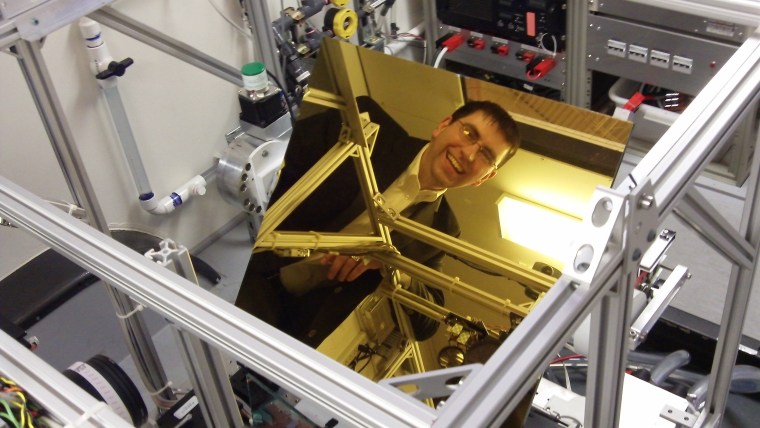Alan Boyle writes: A pint-sized helicopter that gets its energy from a laser beam ran for more than 12 hours straight overnight, breaking an endurance record for laser-powered hovering.
It may look like a toy or a UFO, but the Pelican quadrocopter is actually a prototype for a new generation of mini-drones designed for military use.
The Pelican's landing came this morning -- 12 hours, 26 minutes and 56 seconds after it rose up from the floor of the Future of Flight Aviation Center in Mukilteo, Wash., just north of Seattle.
"It's been a satisfyingly boring night," Tom Nugent, president and co-founder of LaserMotive, told me when I arrived at the museum at 7 a.m. this morning.
Nugent's Seattle-area company won $900,000 last year in the NASA-backed Beam Power Challenge, thanks to the quickness of its laser-powered tether climber. Today's challenge was all about hang time rather than speed or altitude: The Pelican -- built by Ascending Technologies, a German company specializing in flying robots -- never flew much higher than 30 feet, and an autonomous control system kept it pretty much in the same position for hour after hour.
The Ascending Technologies executives who sat behind the computers controlling the craft had little to do except to adjust the software every once in a while. "We act as safety pilots," Michael Achtelik, the German company's CEO, told me.
LaserMotive developed the diode-laser beam system that kept the Pelican aloft. Near-infrared light from the equivalent of 250,000 laser pointers were focused and sent up to shine onto the quadrocopter's photovoltaic array, using a system of lenses and mirrors in the back of a delivery truck. The laser system served as a "wireless extension cord" for the Pelican, Nugent said. But the copter also had a battery capable of keeping the rotors running for a few minutes, just in case something went wrong with the 2.5-kilowatt laser.

Jordin Kare, another one of LaserMotive's co-founders and a pioneer in the field of laser propulsion, said the laser generated enough radiation to heat up your hand if you stuck it in the beam, but nowhere near enough to blast a hole in it. "We've actually cooked hot dogs with that laser, and it takes about four or five minutes," Kare told me. "Not exactly a death ray."
Nevertheless, the copter control team wore protective glasses while the beam was on. Onlookers like myself were kept behind a line of airport-style dividers ... and were advised not to stare at the spots of laser light that reflected off the museum's ceiling. "That is actually 1,000 times brighter than it looks," Kare said.
Just a few minutes after 8 a.m., the laser beam was switched off, and Achtelik fiddled with a hand-held controller to bring the copter down for its landing. "We've just flown for the first time a battery-powered vehicle and charged it while it was flying," Dave Bashford, LaserMotive's vice president of operations, told about 20 spectators at the museum. (In August, LaserMotive pulled off a string of laser-powered flights lasting up to six hours, but in those cases the copter was tethered inside a booth.)
So now what?
Nugent said that LaserMotive will be "going after research-and-development contracts to integrate this into existing UAVs [unmanned aerial vehicles] that are being developed by the military." For example, laser-powered copters could perform on-the-road reconnaissance missions when convoys travel through a combat zone. The beam would come from a portable laser source sitting in the back of a Humvee.
Building a copter that's lightweight as well as battle-tough could be a challenge. Back in 2003, NASA built an experimental laser-powered aircraft that worked well enough inside a building but couldn't stand up to the gusty winds blowing outside. Kare said LaserMotive planned to procure a Puma UAV for future testing.
Looking farther ahead, Nugent said beam-powered aircraft could be used as portable platforms for aerial imaging or civilian communications. "You can have your own personal 'geosynchronous satellite' above you in the atmosphere," he said. Beam systems could come into play in space exploration as well -- perhaps in the form of laser-powered rovers or mini-aircraft on Mars. That's a big reason why NASA provided the prize money for the Beam Power Challenge in the first place.
LaserMotive's prize-winning performance last year proved that beam systems could work over a distance of a kilometer (0.6 miles), and now the company is talking about extending that range to tens or hundreds of kilometers. "I've actually done a design for powering a lunar base from Earth," Kare said. He's also fleshing out a concept he came up with in 1991 to launch single-stage vehicles into orbit using heat exchanger thrusters that are powered by intense laser light.
Ultimately, LaserMotive wants to take beam systems where no lasers have gone before. "We're going for solar system domination," Nugent joked.
Correction for 12:30 a.m. Oct. 29: Tom Nugent points out that LaserMotive's system focuses near-infrared light from the equivalent of 250,000 laser pointers, not 250. I don't know how the wrong number ended up in my notes ... maybe I was dazzled by the laser light. In any case, the number is fixed. Sorry about the error.
Connect with the Cosmic Log community by "liking" the log's Facebook page or following @b0yle on Twitter. You can also check out "The Case for Pluto," Alan's book about the controversial dwarf planet and the search for new worlds.